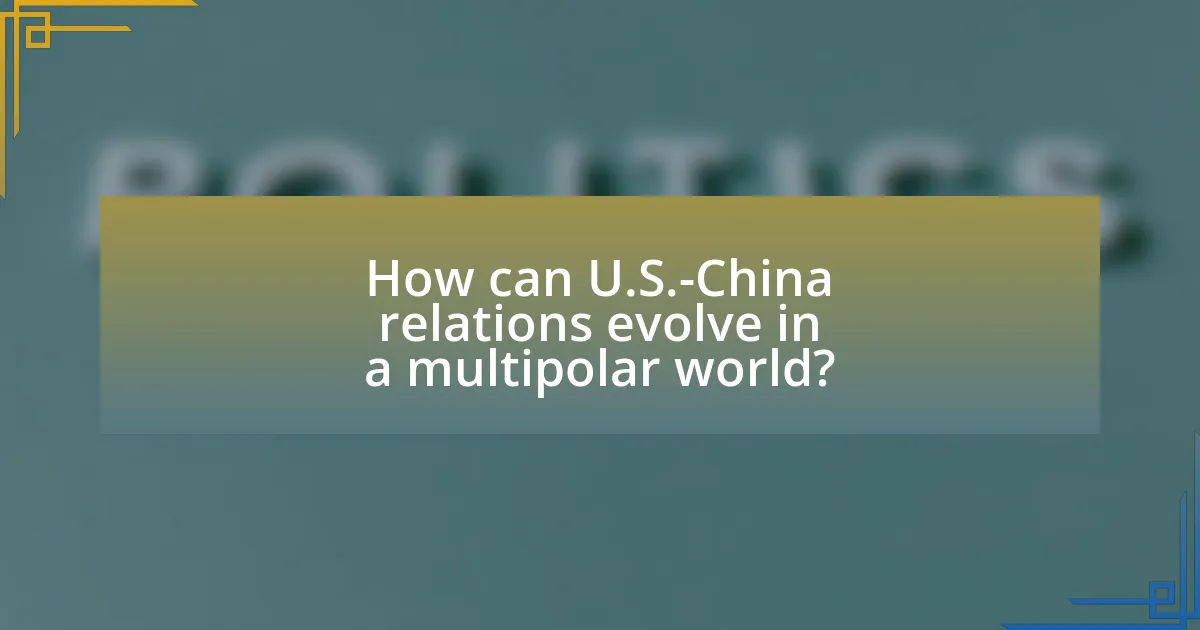The article focuses on the complex dynamics of U.S.-China relations within a multipolar world, highlighting key factors such as economic competition, military tensions, technological rivalry, and global governance challenges. It examines how economic ties, trade policies, and tariffs shape bilateral relations, while also addressing geopolitical considerations, including territorial disputes and military presence. Additionally, the article explores the impact of cultural exchanges, public opinion, and domestic politics on perceptions and interactions between the two nations. It concludes by discussing potential strategies for improving diplomatic relations and the implications of a stable U.S.-China relationship for global stability.

What are the key factors influencing U.S.-China relations in a multipolar world?
The key factors influencing U.S.-China relations in a multipolar world include economic competition, military tensions, technological rivalry, and global governance challenges. Economic competition is evident in trade disputes, with the U.S. imposing tariffs on Chinese goods and China seeking to expand its influence through initiatives like the Belt and Road Initiative. Military tensions arise from territorial disputes in the South China Sea and U.S. support for Taiwan, which complicates diplomatic relations. Technological rivalry is highlighted by competition in areas such as artificial intelligence and cybersecurity, with both nations striving for technological supremacy. Additionally, global governance challenges, including climate change and international health responses, require cooperation but are often hindered by differing national interests and values. These factors collectively shape the complex and evolving dynamics of U.S.-China relations in a multipolar context.
How do economic ties shape the dynamics between the U.S. and China?
Economic ties significantly shape the dynamics between the U.S. and China by creating interdependence that influences diplomatic relations and policy decisions. The U.S. and China are each other’s largest trading partners, with bilateral trade reaching approximately $560 billion in 2021, which fosters cooperation in various sectors while also leading to tensions over trade imbalances and tariffs. This economic interdependence means that actions taken by one country can have immediate repercussions on the other, as seen in the trade war initiated by the U.S. in 2018, which aimed to address trade deficits and intellectual property concerns but also resulted in retaliatory tariffs from China. Such economic interactions not only affect market stability but also impact geopolitical strategies, as both nations navigate their roles in a multipolar world where economic power is increasingly tied to global influence.
What role does trade play in U.S.-China relations?
Trade is a central component of U.S.-China relations, significantly influencing diplomatic interactions and economic policies. The United States and China are two of the largest economies globally, with bilateral trade reaching approximately $615 billion in 2020, making trade a critical factor in their relationship. This economic interdependence creates both cooperation opportunities and tensions, as trade imbalances and tariffs can lead to disputes, exemplified by the U.S.-China trade war initiated in 2018. The ongoing negotiations and agreements, such as the Phase One trade deal in January 2020, highlight the importance of trade in addressing issues like intellectual property rights and market access, further underscoring its role in shaping the broader dynamics of U.S.-China relations.
How do tariffs and trade policies impact bilateral relations?
Tariffs and trade policies significantly impact bilateral relations by influencing economic interactions and diplomatic ties between countries. For instance, when one country imposes tariffs on imports from another, it can lead to retaliatory measures, escalating tensions and potentially resulting in trade wars, as seen in the U.S.-China trade conflict initiated in 2018. This conflict involved the U.S. imposing tariffs on Chinese goods, which prompted China to retaliate with its own tariffs, straining their bilateral relationship and affecting global supply chains. Such trade policies can also affect public sentiment and political discourse, further complicating diplomatic relations.
What geopolitical considerations affect U.S.-China interactions?
Geopolitical considerations affecting U.S.-China interactions include territorial disputes, trade imbalances, military presence in the Asia-Pacific region, and influence over global governance structures. Territorial disputes, such as those in the South China Sea, heighten tensions as both nations assert their claims, impacting diplomatic relations. Trade imbalances, with the U.S. running a significant deficit with China, lead to economic friction and calls for tariffs or trade reforms. The military presence of the U.S. in Asia, including alliances with countries like Japan and South Korea, is perceived by China as a threat to its regional influence. Additionally, both nations vie for leadership in international organizations, shaping global norms and policies, which further complicates their interactions.
How does military presence influence the relationship?
Military presence significantly influences the relationship between the U.S. and China by shaping perceptions of security and power dynamics. The U.S. maintains a military presence in the Asia-Pacific region, which China views as a direct challenge to its sovereignty and regional ambitions. This military positioning can lead to increased tensions, as evidenced by incidents in the South China Sea where U.S. naval operations have prompted strong reactions from China, reflecting a struggle for influence and control. Furthermore, military alliances, such as those between the U.S. and its regional partners, reinforce the perception of encirclement from China’s perspective, complicating diplomatic engagements and fostering an environment of mistrust.
What are the implications of regional alliances on U.S.-China relations?
Regional alliances significantly impact U.S.-China relations by shaping strategic balances and influencing diplomatic interactions. For instance, alliances such as NATO and partnerships in the Indo-Pacific region, including AUKUS and the Quad, create a counterbalance to China’s growing influence, prompting the U.S. to strengthen its military presence and economic ties in these areas. This dynamic can lead to increased tensions, as seen in the South China Sea, where U.S. naval operations challenge China’s territorial claims. Furthermore, regional alliances facilitate collective responses to perceived threats from China, thereby altering the geopolitical landscape and compelling China to adjust its foreign policy strategies.
How do cultural exchanges impact the perception of each country?
Cultural exchanges significantly enhance the perception of each country by fostering mutual understanding and appreciation. For instance, programs like the U.S.-China Cultural Year promote dialogue through art, education, and tourism, which can lead to a more favorable view of each nation among its citizens. Research indicates that increased cultural interactions can reduce stereotypes and misconceptions; a study by the Pew Research Center found that individuals who engage in cultural exchanges are more likely to hold positive views of the other country. This mutual perception shift can influence diplomatic relations and economic partnerships, ultimately contributing to a more cooperative international environment.
What role does media play in shaping public opinion about China in the U.S.?
Media plays a crucial role in shaping public opinion about China in the U.S. by influencing perceptions through news coverage, commentary, and analysis. The portrayal of China in various media outlets often emphasizes issues such as trade disputes, human rights violations, and geopolitical tensions, which can lead to a predominantly negative view among the American public. For instance, a Pew Research Center survey from 2021 indicated that 73% of Americans viewed China unfavorably, a sentiment largely driven by media narratives surrounding the COVID-19 pandemic and China’s global ambitions. This consistent framing in the media not only informs public understanding but also affects policy discussions and political attitudes towards China.
How do educational exchanges contribute to mutual understanding?
Educational exchanges contribute to mutual understanding by fostering direct interactions between individuals from different cultural backgrounds, which enhances empathy and reduces stereotypes. These exchanges allow participants to experience diverse perspectives firsthand, leading to a deeper appreciation of each other’s values and beliefs. For instance, programs like the Fulbright Program have demonstrated that students who study abroad often develop a more nuanced understanding of the host country’s culture and social issues, which can lead to stronger international relationships. Research indicates that such exchanges can significantly improve cross-cultural communication skills, as evidenced by a study published in the Journal of International Education in 2020, which found that participants in educational exchange programs reported increased openness and adaptability in their interactions with people from different cultures.

What challenges do U.S.-China relations face in a multipolar world?
U.S.-China relations face significant challenges in a multipolar world, primarily due to competing national interests, geopolitical tensions, and differing political ideologies. The rise of other global powers, such as India and the European Union, complicates the bilateral dynamics as both nations seek to assert their influence. For instance, the South China Sea disputes exemplify territorial conflicts that heighten military tensions and provoke U.S. responses aimed at maintaining regional stability. Additionally, economic competition, particularly in technology and trade, leads to tariffs and sanctions that strain relations. The ideological divide, with the U.S. promoting democracy and China advocating for authoritarian governance, further exacerbates misunderstandings and mistrust. These factors collectively hinder cooperation on global issues like climate change and public health, illustrating the complexities of navigating U.S.-China relations in a multipolar context.
What are the main sources of tension between the U.S. and China?
The main sources of tension between the U.S. and China include trade disputes, military rivalry, human rights concerns, and technological competition. Trade tensions escalated significantly with tariffs imposed during the U.S.-China trade war, which began in 2018, leading to economic repercussions for both nations. Military rivalry is evident in the South China Sea, where the U.S. conducts freedom of navigation operations to challenge China’s territorial claims, raising the risk of conflict. Human rights issues, particularly regarding China’s policies in Xinjiang and Hong Kong, have prompted U.S. sanctions and condemnation, further straining relations. Additionally, competition in technology, especially in areas like artificial intelligence and telecommunications, has led to restrictions on Chinese companies such as Huawei, reflecting broader concerns about national security and economic dominance.
How do human rights issues affect diplomatic relations?
Human rights issues significantly impact diplomatic relations by influencing the policies and interactions between countries. For instance, when one nation raises concerns about human rights violations in another, it can lead to diplomatic tensions, sanctions, or a reevaluation of trade agreements. A notable example is the U.S. response to China’s treatment of Uyghurs in Xinjiang, which has resulted in sanctions and a deterioration of bilateral relations. This demonstrates that human rights concerns can serve as a catalyst for diplomatic actions, shaping the overall dynamics of international relations.
What is the significance of cybersecurity concerns in the relationship?
Cybersecurity concerns are significant in U.S.-China relations as they directly impact national security, economic stability, and diplomatic trust. The U.S. perceives China’s cyber activities, including state-sponsored hacking and intellectual property theft, as threats to its technological edge and economic interests. For instance, a 2020 report by the U.S. Cybersecurity and Infrastructure Security Agency highlighted that Chinese cyber actors were involved in extensive espionage against U.S. companies and government entities. This ongoing cyber conflict complicates diplomatic negotiations and fosters an environment of mistrust, making it challenging to address broader geopolitical issues effectively.
How does competition for global influence create friction?
Competition for global influence creates friction by intensifying geopolitical tensions between nations, particularly between the U.S. and China. This rivalry manifests in various domains, including trade, military presence, and technological advancements, leading to confrontations such as tariffs, sanctions, and military posturing in contested regions like the South China Sea. For instance, the U.S. has imposed tariffs on Chinese goods to counter perceived unfair trade practices, while China has responded with its own tariffs, escalating economic tensions. Additionally, military exercises and alliances, such as the U.S. strengthening ties with allies in Asia, further exacerbate the friction as both nations seek to assert dominance and secure their interests on the global stage.
What are the implications of China’s Belt and Road Initiative for U.S. interests?
China’s Belt and Road Initiative (BRI) poses significant implications for U.S. interests by expanding China’s geopolitical influence and economic reach across Asia, Europe, and Africa. The BRI aims to enhance infrastructure connectivity and trade, which can lead to increased dependency of participating countries on China, thereby diminishing U.S. influence in these regions. For instance, as of 2021, over 140 countries had signed agreements under the BRI framework, indicating a substantial shift towards Chinese-led economic partnerships. This expansion can challenge U.S. strategic interests, particularly in maintaining a balance of power and securing trade routes. Additionally, the BRI’s financing mechanisms, such as the Asian Infrastructure Investment Bank, provide alternatives to U.S.-led financial institutions, potentially undermining U.S. economic leadership globally.
How does the U.S. respond to China’s growing technological advancements?
The U.S. responds to China’s growing technological advancements through a combination of competitive strategies, regulatory measures, and international alliances. For instance, the U.S. government has implemented export controls on sensitive technologies, such as semiconductors, to limit China’s access to critical components necessary for advanced technology development. Additionally, initiatives like the CHIPS and Science Act aim to bolster domestic semiconductor manufacturing and research, ensuring that the U.S. maintains a technological edge. Furthermore, the U.S. collaborates with allies, such as Japan and the European Union, to establish a unified front against China’s technological influence, promoting shared standards and security measures. These actions reflect a strategic approach to counterbalance China’s advancements while fostering innovation within the U.S.
What role does public opinion play in shaping U.S.-China relations?
Public opinion significantly influences U.S.-China relations by shaping policymakers’ decisions and diplomatic strategies. For instance, rising anti-China sentiment in the U.S. has led to increased scrutiny of trade policies and national security measures, as evidenced by public polls indicating that a majority of Americans view China as a competitor or threat. This perception has prompted U.S. leaders to adopt a more confrontational stance on issues such as trade tariffs and human rights, reflecting the electorate’s concerns. Additionally, public opinion can impact bilateral cooperation on global challenges, as leaders may hesitate to engage with China if domestic sentiment is overwhelmingly negative.
How do domestic politics in the U.S. influence foreign policy towards China?
Domestic politics in the U.S. significantly influence foreign policy towards China through partisan divisions, public opinion, and interest group lobbying. For instance, the U.S. Congress often reflects partisan views, with Republicans typically advocating for a tougher stance on China regarding trade and security issues, while Democrats may focus on human rights and climate cooperation. Public opinion also plays a crucial role; surveys indicate that a majority of Americans view China as a competitor or threat, which pressures policymakers to adopt a more confrontational approach. Additionally, interest groups, such as businesses and labor unions, lobby for policies that align with their economic interests, further shaping the U.S. stance on China. These dynamics illustrate how domestic political factors directly impact the formulation and implementation of U.S. foreign policy towards China.
What impact does nationalism in China have on bilateral relations?
Nationalism in China significantly impacts bilateral relations by fostering a sense of pride and assertiveness that can lead to tensions with other nations, particularly the United States. This assertiveness is evident in China’s territorial claims in the South China Sea and its stance on Taiwan, which often provoke strong reactions from the U.S. and its allies. For instance, the Chinese government’s emphasis on sovereignty and national rejuvenation has resulted in a more confrontational foreign policy, as seen in the increased military presence in disputed areas. Additionally, public sentiment driven by nationalism can pressure Chinese leaders to adopt hardline positions, complicating diplomatic negotiations. This dynamic illustrates how nationalism shapes China’s interactions on the global stage, influencing both cooperation and conflict in bilateral relations.

How can U.S.-China relations evolve in a multipolar world?
U.S.-China relations can evolve in a multipolar world through increased diplomatic engagement and multilateral cooperation. As global power dynamics shift, both nations may seek to address shared challenges such as climate change, public health, and economic stability by participating in international forums and agreements. For instance, the Paris Agreement on climate change exemplifies how both countries can collaborate on global issues despite their competitive rivalry. Additionally, the rise of other powers, such as India and the European Union, may encourage the U.S. and China to find common ground to maintain their influence and stability in a more complex international landscape.
What strategies can be employed to improve diplomatic relations?
To improve diplomatic relations, countries can employ strategies such as open dialogue, cultural exchange programs, and economic cooperation. Open dialogue fosters mutual understanding and addresses grievances directly, as seen in the U.S.-China Strategic and Economic Dialogue initiated in 2006, which aimed to enhance communication on various issues. Cultural exchange programs, like the Fulbright Program, promote people-to-people connections, reducing stereotypes and building trust. Economic cooperation, exemplified by trade agreements, can create interdependence that encourages peaceful relations; for instance, the U.S.-China trade relationship, which has significantly impacted both economies, demonstrates how economic ties can lead to more stable diplomatic interactions.
How can dialogue and negotiation mitigate tensions?
Dialogue and negotiation can mitigate tensions by fostering communication and understanding between conflicting parties. In the context of U.S.-China relations, structured dialogue allows both nations to address misunderstandings, clarify intentions, and find common ground on contentious issues such as trade, security, and human rights. Historical instances, such as the 1972 Nixon visit to China, demonstrate how dialogue can lead to significant diplomatic breakthroughs, reducing hostilities and establishing frameworks for cooperation. Furthermore, negotiation processes, like the U.S.-China Strategic and Economic Dialogue, provide platforms for ongoing discussions that can prevent escalation and promote stability in a multipolar world.
What role do international organizations play in fostering cooperation?
International organizations play a crucial role in fostering cooperation by providing platforms for dialogue, negotiation, and collaboration among member states. These organizations, such as the United Nations and the World Trade Organization, facilitate the establishment of international norms and agreements that promote peace, security, and economic development. For instance, the United Nations has been instrumental in mediating conflicts and promoting sustainable development goals, which are essential for global stability. Additionally, international organizations often provide technical assistance and capacity-building initiatives that enhance the ability of countries to work together on shared challenges, such as climate change and public health crises. This collaborative framework is vital in a multipolar world, where the dynamics of U.S.-China relations are influenced by the need for cooperative engagement on global issues.
What are the potential benefits of a stable U.S.-China relationship?
A stable U.S.-China relationship can lead to enhanced global economic growth and stability. This relationship fosters trade, as both countries are major economic powers; for instance, in 2021, U.S.-China trade reached approximately $750 billion, benefiting industries and consumers in both nations. Additionally, a stable relationship can facilitate cooperation on global challenges such as climate change and public health, exemplified by joint efforts during the COVID-19 pandemic, where collaboration could improve response strategies and resource sharing. Furthermore, stability in U.S.-China relations can reduce the risk of military conflicts, as diplomatic engagement often leads to better communication and conflict resolution mechanisms, thereby promoting regional and global peace.
How can economic collaboration lead to mutual growth?
Economic collaboration can lead to mutual growth by enhancing trade, increasing investment opportunities, and fostering innovation between countries. For instance, when the U.S. and China engage in economic partnerships, they can leverage each other’s strengths; the U.S. provides advanced technology while China offers manufacturing capabilities. This synergy can result in increased productivity and economic expansion for both nations. According to the U.S.-China Economic and Security Review Commission, bilateral trade reached over $600 billion in 2019, demonstrating the significant economic interdependence that can drive mutual growth.
What are the implications of a cooperative approach for global stability?
A cooperative approach significantly enhances global stability by fostering diplomatic relations and reducing the likelihood of conflict among nations. This is evident in historical instances such as the post-World War II era, where cooperation among major powers led to the establishment of international institutions like the United Nations, which aimed to promote peace and security. Furthermore, research indicates that collaborative efforts in addressing global challenges, such as climate change and economic inequality, can lead to more effective solutions and a shared sense of responsibility among nations. For example, the Paris Agreement exemplifies how cooperative frameworks can unite countries towards common goals, thereby contributing to a more stable international environment.
What practical steps can individuals take to understand U.S.-China relations better?
Individuals can enhance their understanding of U.S.-China relations by engaging with diverse sources of information, including books, articles, and documentaries that focus on historical and contemporary issues between the two nations. For instance, reading works like “Destined for War” by Graham Allison provides insights into the Thucydides Trap, which explains the potential for conflict as a rising power challenges an established one. Additionally, following reputable news outlets such as The New York Times or The Economist can keep individuals informed about current events and policy changes. Participating in webinars or lectures hosted by think tanks like the Council on Foreign Relations or the Brookings Institution can also provide expert analysis and foster deeper discussions on the complexities of U.S.-China relations. Engaging in discussions with knowledgeable peers or joining forums dedicated to international relations can further enhance understanding through shared perspectives and debates.
How can one stay informed about developments in U.S.-China relations?
To stay informed about developments in U.S.-China relations, one should regularly follow reputable news sources, academic journals, and government publications that focus on international relations. Major news outlets like The New York Times, The Washington Post, and BBC provide timely updates and analyses on diplomatic events and policy changes. Academic journals such as the Journal of Contemporary China and the China Quarterly publish in-depth research and expert opinions on the dynamics of U.S.-China relations. Additionally, government websites, including the U.S. State Department and the Chinese Ministry of Foreign Affairs, offer official statements and policy documents that are crucial for understanding the current state of affairs. Engaging with think tanks like the Brookings Institution and the Council on Foreign Relations can also provide valuable insights and expert commentary on ongoing developments.
What resources are available for deeper insights into the dynamics of U.S.-China relations?
Key resources for deeper insights into the dynamics of U.S.-China relations include academic journals, think tank reports, and government publications. Notable academic journals such as the “China Quarterly” and “Foreign Affairs” provide peer-reviewed articles that analyze various aspects of the relationship. Think tanks like the Brookings Institution and the Council on Foreign Relations publish in-depth reports and policy briefs that examine current events and strategic implications. Additionally, U.S. government resources, including reports from the Congressional Research Service, offer official analyses and data on trade, security, and diplomatic relations between the two nations. These resources collectively enhance understanding of the complexities involved in U.S.-China interactions.















